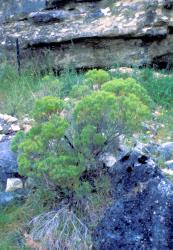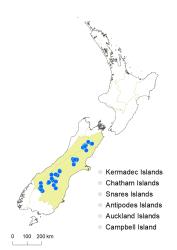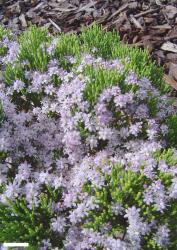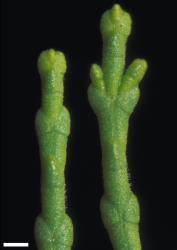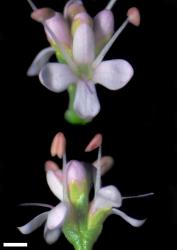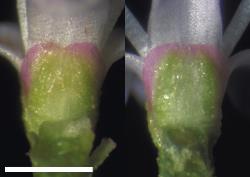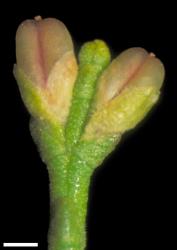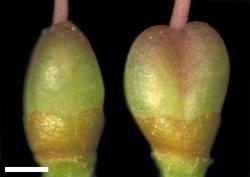- Taxon
- Gallery
- ≡ Hebe cupressoides (Hook.f.) Andersen, Trans. New Zealand Inst. 56: 693 (1926)
- ≡ Leonohebe cupressoides (Hook.f.) Heads, Bot. Soc. Otago Newsl. 5: 8 (1987)
Whipcord shrub to 2 m tall. Stems erect, glabrous or eglandular-pubescent; hairs bifarious. Leaf bud indistinct, its outer leaves fully grown, diverging. Leaves opposite-decussate, connate in pairs and encircling stem, scale-like, appressed (slightly spreading when dry); lamina sub-coriaceous, ovate to deltoid, 0.8–2.0 mm long; 0.4–2.0 mm wide, dull glaucescent to yellowish-green above and beneath; veins not evident; surfaces glabrous or sometimes with dense, minute, glandular hairs; margin eglandular- or glandular-ciliolate, entire; apex sub-acute to obtuse; bases broad; petiole absent. Inflorescence a terminal spike, 3–37 mm long; flowers crowded, 2–22, all bisexual; bracts opposite-decussate, connate, ovate to deltoid; pedicels absent. Calyx lobes 4, seemingly 2–3 because posterior pair completely fused, anterior pair fused ⅔ or more, these pairs fused together to about halfway, obtuse to rounded, 0.5–1.0 mm long, eglandular-ciliate or -ciliolate mixed with short glandular cilia. Corolla 3–4 mm diameter; tube white to purplish, 0.9–1.4 mm long, = calyx, eglandular-hairy inside; lobes 4, white, pink, pale blue or pale purplish, sub-erect to recurved, sub-equal, elliptic, oblong, or sub-orbicular, 2–3 mm long, obtuse; nectar guides absent. Stamen filaments white, 2.1–4.0 mm long, anthers pink, magenta, or brownish. Style glabrous, 2–3 mm long. Capsule angustiseptate, emarginate, glabrous, 1.9–2.4 mm long, 0.9–1.4 mm at widest point. Seeds ovoid, ellipsoid, oblong, or obovoid, weakly flattened, smooth, pale brown, 0.7–1.1 mm long.
Veronica cupressoides is a distinctive species with a unique combination of characters: a whipcord growth form with tiny appressed, scale-like, dull to glaucescent leaves; long internodes (two to three times the leaves) with conspicuous nodal joints where the leaves are attached; the calyx lobes all fused for about half their length, the posterior pair completely fused, and the anterior pair fused ⅔ or more; narrow elliptic or oblong sub-equal corolla lobes; and angustiseptate capsules. Other unique features are the nectarial disc covering the lower third of the ovary at flowering and the aromatic foliage.
South Island: Marlborough (south-west), Canterbury (eastern foothills), and Otago (western parts, south to Wye Creek).
Montane, in scrub, rock outcrops, moraine, and slips, often near lakes and streams. Recorded elevations range from 300 to 1372 m.
Flowers: December–February; fruits: February–May (persisting all year).
2n = 42 (see Bayly & Kellow 2006, as Leonohebe cupressoides).
Veronica cupressoides is classified in V. subg. Pseudoveronica sect. Hebe and informally in the “semi-whipcord hebe” group (Albach & Meudt 2010). It is sister to the other semi-whipcord hebes, which are smaller subshrubs with similar, rather glaucous leaves but short internodes.



